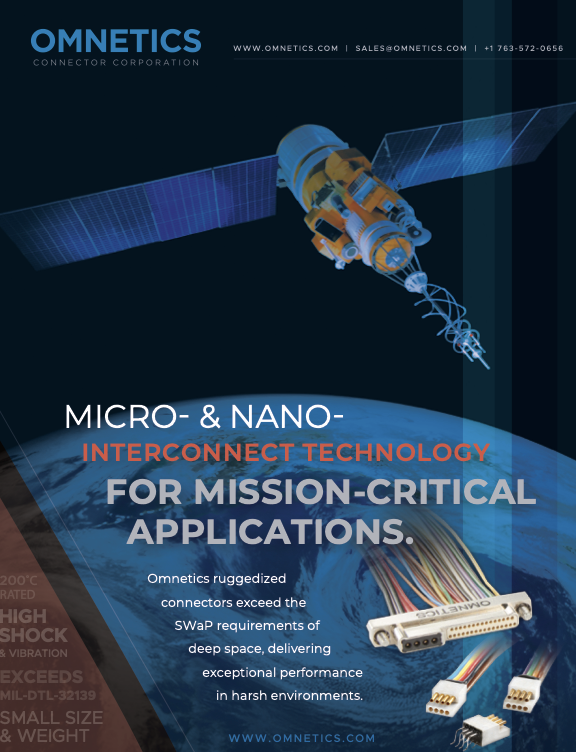AAC Clyde Space + partners create hub for laser comms in the Netherlands
AAC Clyde Space and the company’s partners are creating a hub for laser satellite communications in the Netherlands, supported by agreements with Dutch TNO and FSO Instruments.
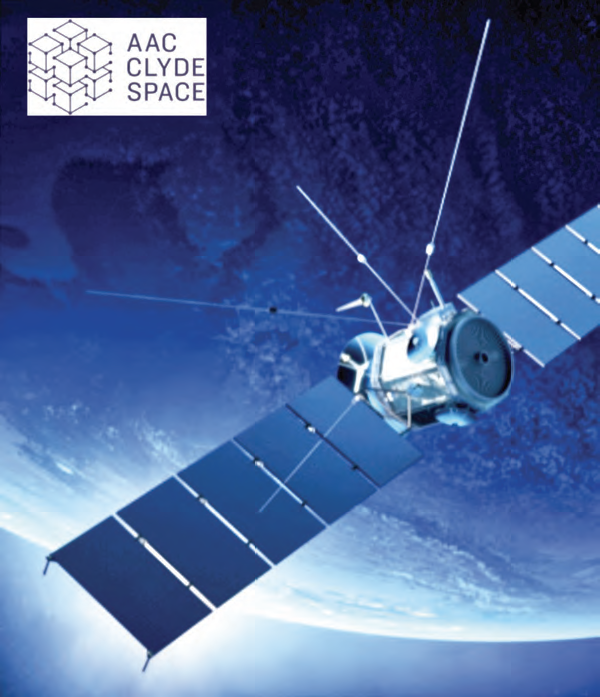
The agreement marks all three parties’ commitment to build up a long-term partnership and aims to establish a European ecosystem for laser satellite communication based in the Netherlands.
This news follows the earlier announcement of the parties forming a consortium to develop the next generation of laser communication terminals for small satellites, link to press release.
In this latest project, AAC Clyde Space partners is set to deliver a next- generation compact, low-cost, laser system capable of transmitting data from space at a speed of up to 10 Gbps to enable space-to-ground communication between small satellites and optical ground stations. This is several times faster than current laser communication systems, and is far outpacing the radio frequencies in use today.
AAC Clyde Space has entered into a licensing agreement with TNO which grants AAC Clyde Space the right to use TNO’s cutting-edge laser communication terminal technology. Measuring 10 x 10 x 10 cm the terminal is ideally suited for small satellites.
The group has also entered a memorandum of understanding (MoU) with FSO Instruments regarding joint support in the development of a manufacturing and marketing.
FSO will provide additional optical technology to the project. AAC’s subsidiary in the Netherlands, AAC Hyperion, will provide optical communications for onboard electronics, drivers and software to the laser system.
Additional details: rb.gy/1kfjjm
Northrop Grumman expands satellite life-extension services
Northrop Grumman Corporation’s (NYSE: NOC) SpaceLogistics LLC announced its agreement to extend, by four years, the on-orbit life- extension services the firm’s Mission Extension Vehicles (MEVs) provide to satellite operator, Intelsat.
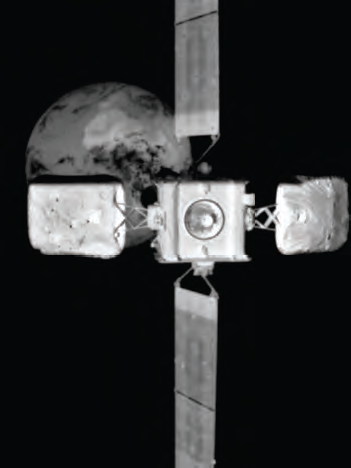
An image of Intelsat 10-02 taken by MEV-2’s
infrared wide field of view camera at 15m away.
Photo is courtesy of Northrop Grumman
At the end of the current servicing period, MEV-1 will relocate and release the Intelsat 901 (IS-901) satellite into the GEO graveyard and provide service for another Intelsat satellite. MEV-2 will remain docked to Intelsat’s current vehicle, Intelsat 10-02 (IS-10-02), providing life-extension for an additional four years, nearly doubling service from the original contract.
Northrop Grumman remains committed to its legacy of space sustainability beginning when MEV-1 performed the first-ever in- orbit commercial spacecraft docking with IS-901.
In 2021, the company achieved another milestone when MEV-2 docked with IS- 10-02 while the satellite was in operation, with no reported disruption in service during the docking.
The initial service period was for five years for both MEVs.
With these new contract amendments, the lifespans of several commercial GEO satellites will be extended for an additional four years.
Additional information: rb.gy/p57ga5
PLD Space invests 10 million euros in their MIURA 5 launch complex in French Guiana
PLD Space has invested 10 million euros in the MIURA 5 Launch Complex at Guiana Space Center (CSG), Europe’s spaceport in Kourou (French Guiana), owned by the French Space Agency (CNES) and the European Space Agency (ESA).

With the first launch of its rocket at the end of 2025, PLD Space will become the first, non-institutional, launch operator that will go to orbit from this historical base. PLD Space has always been committed to the CNES/CSG as the main site for MIURA 5 recurrent launches as the venue is the most competitive launch base in Europe and enables the launch vehicle to achieve any orbit.
Following the binding agreement signed with CNES in June 2023, PLD Space is ready to start the civil works of its Launch Complex in the ELM-Diamant site at CSG after summer 2024 with the support of the French Authorities. PLD Space plans to make a very efficient 10 million euros investment for the construction of the main launch site for MIURA 5, the necessary infrastructure during the launch campaign and preparations for the recovery of the rocket, a pioneer in the application of the reusability feature in its segment.
To this end, PLD Space has established a French subsidiary in Kourou and is formalizing with CNES the contracts that will allow it to initiate the first investments in Kourou. Furthermore, the company is firmly committed to the generation of sustainable local wealth and its plan is to incorporate industrial suppliers from the region in order to consolidate a strong local supply chain.
PLD Space has a total of 15,765 square meters at the ELM-Diamant site. This area is divided between its own launch zone and a preparation area, comprising an integration hangar, a clean room, a control center, and both commercial and work offices.
CNES undertakes to provide the “common means” for MIURA 5 launch operations, such as road access, electricity supply, fire water network and access controls to the general complex. The French space agency also will make an area of the CNES/CSG available to PLD Space, where the launch zone will be located.
For its side, PLD Space undertakes to develop the specific means needed for MIURA 5’s integration, testing and launch operations at the CNES/CSG base. Project progress is on schedule and civil works for the complex are expected to start after this summer. The company’s plan targets mid-2025 for Launch Complex acceptance to begin MIURA 5 launch campaign by the end of 2025.
Initially, PLD Space will create more than ten direct jobs and 50 indirect in Kourou, a figure that will grow progressively as the number of launches increases.
“Our first approach to our colleagues in French Guyana was in 2018, proud to start our operations in Kourou as the original commercial launcher company in Europe,” said the Chief Business Development Officer and Co-founder of PLD Space, Raúl Verdú. “For PLD Space, it is also the opportunity to close the circle by developing, manufacturing, testing and also launching rockets to orbit from European territory. The space launch industry has a catalyst effect on investment and creates a ‘pull effect’ on the whole economic structure of the area. We want as many of flights as possible to take place from the Europe’s spaceport, appropriate sizing of the local team.”
Ovzon receives 12-months renewal for continued support to UK MoD
Ovzon has, for the fourth consecutive year, been awarded a 12-months service renewal contract for delivery of Ovzon SATCOM-as-a- Service to the UK MoD.
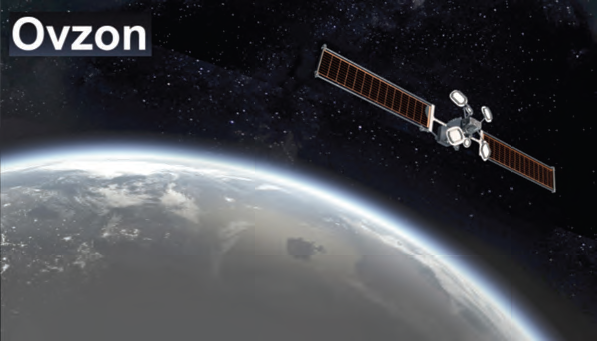
The order was received from Babcock International, an international defense, aerospace and security company, with the total order value amounts to approximately $1 million.
Ovzon’s SATCOM-as-a-Service offering includes high performing and resilient satellite network, and the industry leading Ovzon T6 “On-The-Pause” mobile satellite terminals, as well as gateway services and Ovzon’s dedicated customer service and support. The service is
relied upon by the UK and many western governments when resilient, no-fail communications are required. Additional information: rb.gy/9topl9
Also, Ovzon 3 reached GEO and successfully concluded the initial satellite tests. Initial tests were conducted by the manufacturing partner, Maxar, and the satellite, including the Ovzon On-Board- Processor, will soon be handed over to Ovzon for further on-orbit testing.
The satellite is expected to enter commercial service mid-year 2024; all according to plan.
Earlier in the second quarter 2024, Ovzon announced two new SATCOM-as-a-Service offerings for the Ovzon 3 satellite, tailored to meet customers’ needs for performance, mobility, and resiliency. The new services, Ovzon Pegasus and Ovzon Orion, are based on the unique technology and capabilities of the Ovzon 3 satellite and the Ovzon On-Board-Processor.
Kepler Communications has validated the firm’s OISLs between two data relay satellites in LEO
Kepler Communications recently successfully validated optical inter- satellite links (OISLs) between two data relay satellites in LEO.
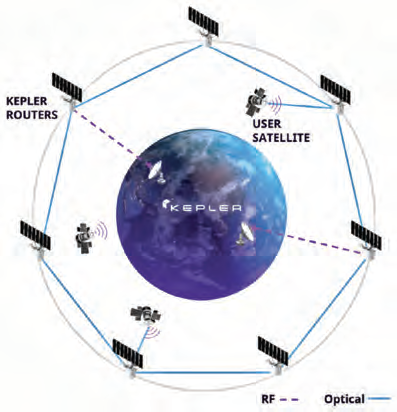
Graphic illustration, left, of The Kepler Network’s infrastructure designed for space-to-space data relay. Illustration is courtesy of Kepler Communications
During a commissioning and early operations phase, Kepler established optical inter-satellite links between two Pathfinder satellites equipped with Space Development Agency (SDA) compatible Tesat SCOT80 optical terminals.
The first file transferred over the optical connection was a recent picture of Kepler’s global team gathered near its headquarters in Toronto, Canada (photo below). In the first week of testing, the company successfully sent diagnostic data between the two spacecraft, and the full link performance was demonstrated according to the SDA standard. In addition, multiple acquisition scenarios were tested, and both terminal and spacecraft performed optimally.
In addition to initial optical link commissioning, the company has demonstrated Internet Protocol (IP) mesh networking on-orbit by communicating with multiple satellites in real time over a single ground link, using standard protocols including Secure Shell (SSH), Transmission Control Protocol (TCP), and User Datagram Protocol (UDP).
Kepler is scaling operations to deploy the first Tranche of its next-generation constellation and expects to offer initial optical services in 2025. The hybrid optical data relay network builds on flight heritage from Kepler’s existing constellation of 21 RF satellites. The Kepler Network provides customers with always-available coverage in LEO, streamlining on-orbit communications with sub-second end-to-end latency, gigabit throughputs, and onboard processing to enable access to space-generated data in near-real time.
Established in 2015, Kepler has quickly grown into a global space company and provides secure optical data relay services to government and commercial missions as a partner in modern space communications. The company’s investors include IA Ventures, Costanoa Ventures, Canaan Partners, Tribe Capital, BDC Capital’s
Industrial Innovation Venture Fund, and other leading investors. The Canadian Space Agency (CSA) also contributed a grant toward the completion of the Pathfinder technology.
Spacemanic wins Prix Bulles Pierre Cardin
Spacemanic wins the category Space for our planet 2024 — the Prix Bulles Cardin recognizes innovation in space and ocean exploration technology with the goal of protecting our planet — this award attests to the commitment of Maison Pierre Cardin toward sustainability, focusing on the opportunities presented by the space and nautical sectors to build a better future. The Prix Bulles Cardin selects nine nominees each year and awards three projects.
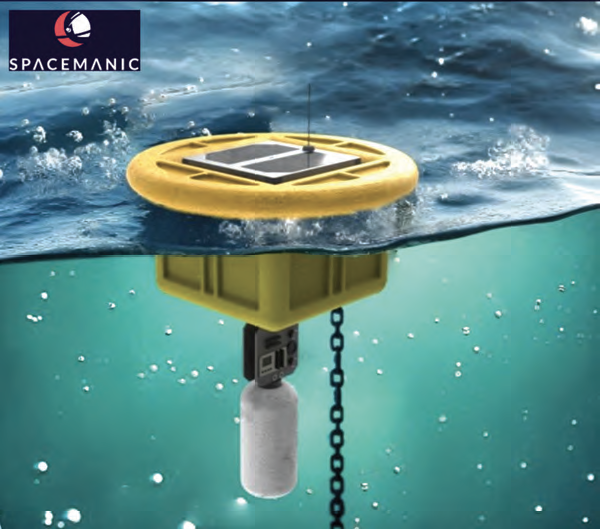
Spacemanic always participates in a variety of grant initiatives and projects aimed at the space industry. This one was different as the focus was on the Earth’s oceans and their protection using space technology. The company decided to approach the matter via the firm’s CubeSat design with some some waterproofing and the addition of a flotation device — and the WaterCube was finalized.
WaterCube is a practical sea pollution detection system based on a CubeSat satellite platform, leveraging our know-how gathered through nanosatellite missions. By detecting and monitoring pollution sources such as sewage water, oily ballast water, bilge water dumping, and engine effluent discharges, the initiative raises awareness about the environmental impact of unsustainable maritime practices.
Through this awareness, industries and stakeholders are encouraged to adopt cleaner and more sustainable practices, thus reducing pollution and preserving marine ecosystems.
Additional information: rb.gy/1kfjjm


